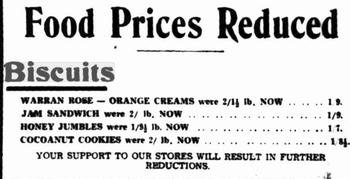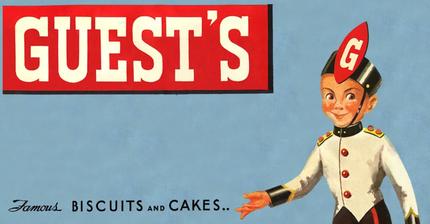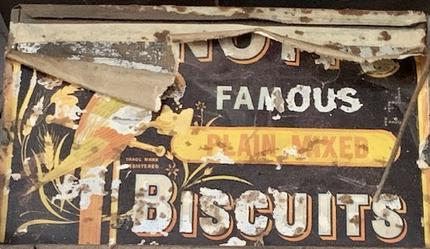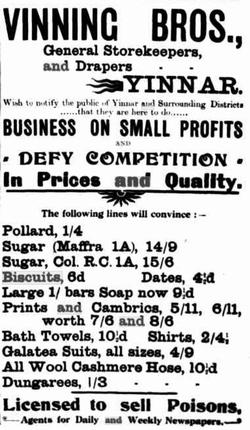Looking Back - March 2024 - Do you remember biscuits?
By Leo Billington

In May 2023, someone commenting on social etiquette, suggested dunking biscuits into a cup of tea is frowned upon.
“We should never dunk anything into our cups of tea. If you dunk a biscuit in your tea, it will change the flavour of the tea, you will get some biscuit at the bottom of it, and it will be all soggy. You don't want to be doing it. The idea of a cup of tea is that you sip and enjoy it.”
An unattractive sludge wallowing in a cup! Worse still, what if that biscuit had a central creamy section and the sludge was really messy. One has to devise a devious strategy to extract it without being seen.
For us, biscuits have been central to our lifestyles for a long time. When next in a supermarket, check out what is available for customer selection. Stand still, study a plethora of brands, make a selection and head home to make a pot of tea.
From early 1861, Peek, Frean & Co Ltd began exporting biscuits to Australia. Seventy years later, personnel from their London factory arrived in Australia to establish a new factory in Sydney. In 1982, Peek Frean & Co became part of Nabisco, which in turn, was taken over by the R J Reynolds Tobacco Company three years later.

However, Australia’s demand for biscuits encouraged our own manufacturers to meet an insatiable demand. Thomas Bibby Guest was making biscuits in his Sydney factory about 20 years before William Arnott established his Steam Biscuit Factory.
Guest arrived here in 1852 and soon made his mark making biscuits. Popular lines included Teddy Bears, Ginger Nuts, Butternut Snaps, and later, after Thomas’ death, his son expanded, producing Nice, Marie, Thin Captain, Bourbon Slice, and Maltex Creams.

A baker by trade, William Arnott opened his first factory in Newcastle, (known as William Arnott’s Steam Biscuit Factory) in 1875, and launched the famous Arnott’s Milk Arrowroot biscuits in 1882. The well-known parrot logo, which still adorns Arnott’s trucks, was introduced in 1888.
In 1906, Arnotts launched Iced Vo Vos and SAOs, while other new products at the time were Malt’O’Milk, Keil Fingers (later called Scotch Fingers), Ginger Nuts and Milk Coffee.
Rapid expansion meant a new factory was built at Homebush in 1907. By the end of the decade, the company had approximately 150 biscuit varieties in the range. The Family Assorted range appeared around 1924, available in 7lb (3.2kg) and 4lb (1.8kg) tins, while the popular Monte Carlo was introduced in 1926.

Soon customers were confronted by lots of varieties; in 1858, Swallow and Ariel established a factory in Port Melbourne manufacturing Ginger Nuts, Uneeda, Marie and Melba Wafers. Then, the hysteria around gold rush years helped profitability; “fancy” biscuits and ship’s biscuits became the company’s mainstay products.
Then, along came Adolf Frederick Brockhoff. It is debatable when he started production - either 1860 or 1880 - but nonetheless, well-known biscuits included, Chocolate Royals, Chocolate Ripple, Trellis, Currant Shorties and Salada. The company amalgamated with Arnotts in 1964.
In Ballarat, James Long established his confectionary business in 1854, before diversifying into biscuits. His Sunshine Biscuit Ltd enterprise concentrated mainly on crackers and Hydrox (creame filled chocolate sandwich) which was surpassed by its imitation - Oreo.
We must not forget Table Talk biscuits, manufactured in Prahran and boasting to be the first company to package its’ biscuits in cellophane. Its’ products included Calypso Creams, Coffee Sticks and Mint Cremes. The company benefitted greatly from its marketing slogan - “easy to see they’re fresh.”
Locally, a variety of small shopkeepers advertised that they sold biscuits. R. A. Baker, in 1899, advertised he was a baker, fruiterer, confectioner, able to cater for picnics, balls and weddings. His Morwell and Yinnar bakeries baked biscuits “of every description.”
Biscuit barrels became a common wedding gift - in Mid - December 1909, Mr John Hall, the proprietor of the Universal Emporium, “imported a consignment of goods for the Xmas trade direct from London, among which are Santa Claus puddings, wine biscuits, afternoon biscuits, and treasure biscuits.”
Noy and Nash sold biscuits at their Morwell Bakery and General Store during the pre-World War 1 years. Later on, Ted Nash continued as a grocer and many former residents remember that “the brown paper bag of biscuits would be twirled around to curl the bag top corners, sealing the contents inside.”

Fruiterer and Confectioner, Tom Furlong also sold biscuits in his Commercial Road shop. His wooden shop, with a brick facade, was significantly damaged in a major fire which broke out on Saturday night, November 16, 1929.
Wilkinson’s Myola Cafe provided teas and biscuits, and presumably cake. Popular Morwell business identity at the time, Mr Dave Hinkley, purchased Wilkinson’s business in February, 1948. During the early 1950s, Hinkley Stores, Moe, Yallourn and Morwell, was a keen advertising client for the local newspaper. Biscuits always seemed as prominent as fruit and vegetables.
In Yinnar, Vinning Bros. advertised biscuits as did Rockmans in Yallourn, as well as all W. A. Purvis stores across Gippsland.
Who remembers going into Jenkins’ Emporium at the Tarwin/George Street corner asking for either threepence, or, sixpence worth of broken biscuits? Morwell dentists clapped their hands with glee.


